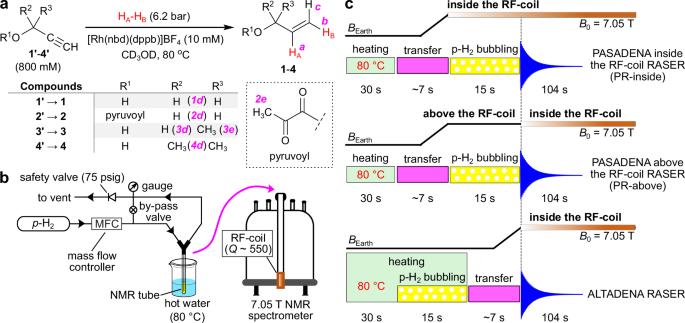通过受激辐射发射进行穿透结合和穿透空间射频放大
IF 5.9
2区 化学
Q1 CHEMISTRY, MULTIDISCIPLINARY
引用次数: 0
摘要
受激辐射发射的无线电放大(RASER)是在强负极化系统的核磁共振(NMR)实验中观察到的一种现象。这种现象可用于产生非常窄的 NMR 线、无背景 NMR 光谱以及化学转化的无激发感应。最近,有人提出了通过副氢诱导极化(PHIP)产生 RASER 的新方法。在这里,我们展示了在各种丙炔化合物中成对加入对氢,可诱导反应中化学引入的质子以外的其他质子产生 RASER 活性。在高场 PHIP 中,启动 RASER 的负极化是通过分子内交叉松弛转移的。当在地球磁场中加入对氢,然后绝热转移到高磁场时,其他质子的 RASER 活性会通过 J 偶联和交叉松弛作用被诱导出来。这种 RASER 的穿透键和穿透空间诱导为 RASER 应用的不断发展和扩展提供了潜力,并有可能提高二维 NMR 光谱技术的光谱分辨率。受激辐射发射无线电放大(RASER)可产生非常窄的 NMR 线、无背景 NMR 光谱和化学转化的无激发感应。在此,作者展示了在各种丙炔化合物中成对加入对氢,通过通键或通空相互作用,诱导反应中化学引入的质子以外的其他质子的 RASER 活性。本文章由计算机程序翻译,如有差异,请以英文原文为准。

Through-bond and through-space radiofrequency amplification by stimulated emission of radiation
Radio Amplification by Stimulated Emission of Radiation (RASER) is a phenomenon observed during nuclear magnetic resonance (NMR) experiments with strongly negatively polarized systems. This phenomenon may be utilized for the production of very narrow NMR lines, background-free NMR spectroscopy, and excitation-free sensing of chemical transformations. Recently, novel methods of producing RASER by ParaHydrogen-Induced Polarization (PHIP) were introduced. Here, we show that pairwise addition of parahydrogen to various propargylic compounds induces RASER activity of other protons beyond those chemically introduced in the reaction. In high-field PHIP, negative polarization initiating RASER is transferred via intramolecular cross-relaxation. When parahydrogen is added in Earth’s field followed by adiabatic transfer to a high field, RASER activity of other protons is induced via both J-couplings and cross-relaxation. This through-bond and through-space induction of RASER holds potential for the ongoing development and expansion of RASER applications and can potentially enhance spectral resolution in two-dimensional NMR spectroscopy techniques. Radio Amplification by Stimulated Emission of Radiation (RASER) may produce very narrow NMR lines, background-free NMR spectroscopy, and excitation-free sensing of chemical transformations. Here, the authors show that pairwise addition of parahydrogen to various propargylic compounds induces RASER activity of other protons beyond those chemically introduced in the reaction via through-bond or through-space interactions.
求助全文
通过发布文献求助,成功后即可免费获取论文全文。
去求助
来源期刊

Communications Chemistry
Chemistry-General Chemistry
CiteScore
7.70
自引率
1.70%
发文量
146
审稿时长
13 weeks
期刊介绍:
Communications Chemistry is an open access journal from Nature Research publishing high-quality research, reviews and commentary in all areas of the chemical sciences. Research papers published by the journal represent significant advances bringing new chemical insight to a specialized area of research. We also aim to provide a community forum for issues of importance to all chemists, regardless of sub-discipline.
 求助内容:
求助内容: 应助结果提醒方式:
应助结果提醒方式:


